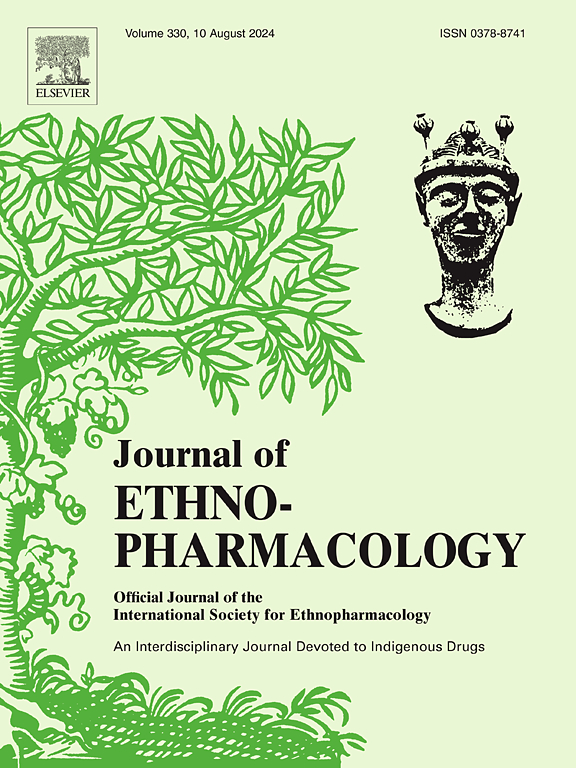利用谱效关系、血清代谢、分子对接与化学计量学相结合的方法探索不同产地莪术的质量标记。
IF 4.8
2区 医学
Q1 CHEMISTRY, MEDICINAL
引用次数: 0
摘要
本文章由计算机程序翻译,如有差异,请以英文原文为准。

Exploring the quality marker of Curcumae kwangsiensis radix from different production regions using the spectrum-effect relationship, serum metabolism, and molecular docking integrated with chemometrics
Ethnopharmacological relevance
Curcuma kwangsiensis radix (CKR) is one of the most important herbs in traditional Chinese medicine. It effectively enhances blood circulation and eliminates stasis, which is highly associated with thrombosis. Furthermore, CKR is primarily produced in the Guangxi and Yunnan provinces of China. However, the quality control indicators of CKR in different production regions remain controversial.
Aim
To explore the quality marker (Q-Marker) of CKR in different production regions.
Materials and methods
First, we determined the UPLC fingerprints of CKR from different production regions. Second, in vitro, antiplatelet aggregation biopotency (AAB) was measured using a parallel-line assay based on the quantitative response method of the bioassay. We identified CKR components and their serum metabolism using UPLC-Q-TOF-MSE. Subsequently, molecular docking technology was used for Q-Marker analysis. Finally, we established a method for the quantitative analysis of Q-Marker.
Results
We observed significant differences of CKR between the Guangxi and Yunnan provinces according to the UPLC fingerprint and AAB results. Eight quality control-relevant components were screened using orthogonal partial least squares based on the spectrum-effect relationship. UPLC-Q-TOF-MSE identified 57 CKR components, and 10 prototype components and 11 metabolites, respectively, were detected during serum metabolism. Ultimately, curcumenone was screened as a Q-Marker using the spectrum-effect relationship integrated with serum metabolism, which positively correlated with the quality. The AAB results of the Q-Marker indicated that curcumenone exhibited significant anti-platelet aggregation activity. The results of the Q-Marker molecular docking revealed the strongest binding effect between curcumenone and the GP-IIb/IIIa receptor, whereas that between the P2Y12 receptor and the P2Y1 receptor was the weakest. In addition, quantitative analysis of the Q-Marker indicated that there were significant differences in the contents of the Q-Marker from different production regions.
Conclusions
We identified a Q-Marker for CKR that can provide a foundation for quality evaluation research from different production regions.
求助全文
通过发布文献求助,成功后即可免费获取论文全文。
去求助
来源期刊

Journal of ethnopharmacology
医学-全科医学与补充医学
CiteScore
10.30
自引率
5.60%
发文量
967
审稿时长
77 days
期刊介绍:
The Journal of Ethnopharmacology is dedicated to the exchange of information and understandings about people''s use of plants, fungi, animals, microorganisms and minerals and their biological and pharmacological effects based on the principles established through international conventions. Early people confronted with illness and disease, discovered a wealth of useful therapeutic agents in the plant and animal kingdoms. The empirical knowledge of these medicinal substances and their toxic potential was passed on by oral tradition and sometimes recorded in herbals and other texts on materia medica. Many valuable drugs of today (e.g., atropine, ephedrine, tubocurarine, digoxin, reserpine) came into use through the study of indigenous remedies. Chemists continue to use plant-derived drugs (e.g., morphine, taxol, physostigmine, quinidine, emetine) as prototypes in their attempts to develop more effective and less toxic medicinals.
 求助内容:
求助内容: 应助结果提醒方式:
应助结果提醒方式:


